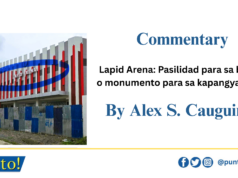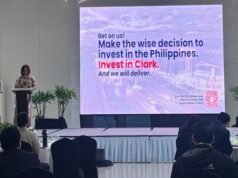CABANATUAN CITY – “To know that your father is a national artist is a great pride.” Thus, Dr. Florino Francisco, a pediatrician, said of the news that his late father was named National Artist for Literature.
Francisco said his family has yet to know who actually nominated Lazaro Francisco, a novelist, for the award but “we were overwhelmed.”
One of the six surviving children of Lazaro, the pediatrician is handpicked by the family members to receive the award, to be given posthumously on still unset date.
The awarding is being hounded by controversies as some quarters protested the naming of the controversial movie director Carlo Caparas and Cecille Alvarez, as among the awardees.
He, however, admitted that the family has long waited for the award since their father died in 1980. “Noon pa sinasabi kasi ng mga critics na pang National Artist siya,” Francisco said. But the late social critic-novelist Francisco, the doctor said, has told them that awards were never asked.
“Pag para sa iyo, para sa iyo,” he said, quoting his father.
Born in Orani, Bataan in 1898, Franciso was 16 years old when his family settled in Cabanatuan City where he finished his grade 7. Right after graduating grade 7, an elementary level, Francisco took and topped the Third Degree Civil Service Eligibility which qualified him to work at the provincial government of Nueva Ecija.
He started writing in 1925 and came up with at least 12 novels and essays since. Five of his writings brought Francisco to his early fame.
These include “Tatsulok”, which won him top award in the Commonwealth Literary Contest.
“Siya kasi ay social critic visionary na na-foresee na mga kailangan ng bayan halimbawa abolisyon ng tenancy system that is way back in 1965,” Francisco, quoting sources from the National Historical Institute (NHI) said of his father.
The NHI has established a marker beside the stage of the Lazaro Francisco Elementary School (formerly Cabanatuan West Central School) years before this National Artist for Literature is announced. The NHI also prodded the Franciscos to institute a museum at their ancestral house in Barangay Bonifacio, also of this city.
Francisco’s first novel “Ama” dealt about the evils of the tenancy system. “Naging kapatas din kasi siya sa pagsasaka.”
Francisco also wrote “Singsing na Pangkasal, Sugat ng Ala-ala, Maganda Pa ang Daigdig, among others.
But the most touching for the family was Sugat ng Ala-ala because of its plot which runs with Francisco’s own life.
“It was about the Second World War, may konting romance pero ipinakita na dun yung mga sacrifices na ginawa ng Filipino para sa pagtatanggol sa bayan. At saka bukod pa dun kaya personal, his eldest son, ‘yung kuyang namin, at yung youngest brother niya, nag volunteer sila at napadala sa Bataan,” he stressed.
Francisco admitted having some degree of interest in writing. But his father made him understand the essence of writing.
“Ang bawat susulatin ay dapat may epekto sa tao, sa bayan at sa daigdig.”
Among the awards received by Francisco were the Republic Cultural Heritage Award from the Philippine government, Patnubay ng Kalinangan award by the City of Manila, Dangal ng Lahi award by the Quezon City government, Tanglaw ng Lahi by Ateneo de Manila University and Gawad Panitik.
Francisco said his family has yet to know who actually nominated Lazaro Francisco, a novelist, for the award but “we were overwhelmed.”
One of the six surviving children of Lazaro, the pediatrician is handpicked by the family members to receive the award, to be given posthumously on still unset date.
The awarding is being hounded by controversies as some quarters protested the naming of the controversial movie director Carlo Caparas and Cecille Alvarez, as among the awardees.
He, however, admitted that the family has long waited for the award since their father died in 1980. “Noon pa sinasabi kasi ng mga critics na pang National Artist siya,” Francisco said. But the late social critic-novelist Francisco, the doctor said, has told them that awards were never asked.
“Pag para sa iyo, para sa iyo,” he said, quoting his father.
Born in Orani, Bataan in 1898, Franciso was 16 years old when his family settled in Cabanatuan City where he finished his grade 7. Right after graduating grade 7, an elementary level, Francisco took and topped the Third Degree Civil Service Eligibility which qualified him to work at the provincial government of Nueva Ecija.
He started writing in 1925 and came up with at least 12 novels and essays since. Five of his writings brought Francisco to his early fame.
These include “Tatsulok”, which won him top award in the Commonwealth Literary Contest.
“Siya kasi ay social critic visionary na na-foresee na mga kailangan ng bayan halimbawa abolisyon ng tenancy system that is way back in 1965,” Francisco, quoting sources from the National Historical Institute (NHI) said of his father.
The NHI has established a marker beside the stage of the Lazaro Francisco Elementary School (formerly Cabanatuan West Central School) years before this National Artist for Literature is announced. The NHI also prodded the Franciscos to institute a museum at their ancestral house in Barangay Bonifacio, also of this city.
Francisco’s first novel “Ama” dealt about the evils of the tenancy system. “Naging kapatas din kasi siya sa pagsasaka.”
Francisco also wrote “Singsing na Pangkasal, Sugat ng Ala-ala, Maganda Pa ang Daigdig, among others.
But the most touching for the family was Sugat ng Ala-ala because of its plot which runs with Francisco’s own life.
“It was about the Second World War, may konting romance pero ipinakita na dun yung mga sacrifices na ginawa ng Filipino para sa pagtatanggol sa bayan. At saka bukod pa dun kaya personal, his eldest son, ‘yung kuyang namin, at yung youngest brother niya, nag volunteer sila at napadala sa Bataan,” he stressed.
Francisco admitted having some degree of interest in writing. But his father made him understand the essence of writing.
“Ang bawat susulatin ay dapat may epekto sa tao, sa bayan at sa daigdig.”
Among the awards received by Francisco were the Republic Cultural Heritage Award from the Philippine government, Patnubay ng Kalinangan award by the City of Manila, Dangal ng Lahi award by the Quezon City government, Tanglaw ng Lahi by Ateneo de Manila University and Gawad Panitik.




